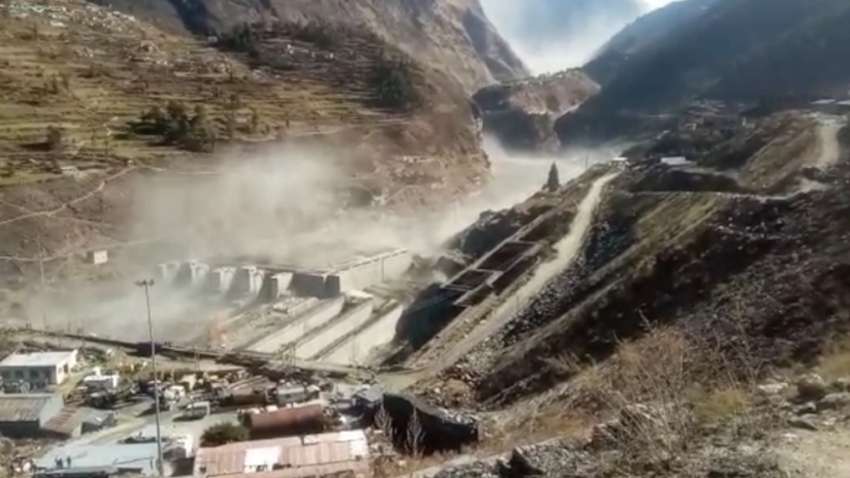After the analysis, a team of researchers has concluded that the natural lake that was formed as a result of flash floods holds enough potential to cause a fresh deluge. With this, the team has also found that the depth of the lake is somewhere between 8-9 metres and has 50,000 cubic metres of water.
The flash floods that caused massive havoc in the upper reaches of Uttarakhand are yet to be fully analysed and in this regard a joint operation by the Indian Airforce and Indian Navy was carried out to make a sense of geological consequences. In the joint operation led by IAF, the divers of Indian Navy have plunged into the lake in order to measure its depth.
After the analysis, the team has concluded that the natural lake that was formed as a result of flash floods holds enough potential to cause a fresh deluge. With this, the team has also found that the depth of the lake is somewhere between 8-9 metres and has 50,000 cubic metres of water in it.
The lake which falls upstream of the RishiGanga river witnessed a half-an-hour operation by the Navy personnel who swam across the length and breadth of the lake. They measured depth at five different spots in the lake where the average depth has been found to be around eight metres. In hindsight, this operation will help scientists in determining the pressure exerted by water on the walls of natural dams made by the lake.
In addition to this, the State Disaster Relief Force (SDRF) has also deployed antenna systems at the site for better communication as currently there are 10 scientists from different geological institutions who are carrying out the research work at the site.
According to Professor YP Sundriyal from HNB Garhwal University, water from the newly formed lake is slowly getting discharged through narrow channels. At present, geologists are still looking for these channels. Besides, the wall holding a massive amount of water in the lake is made of stone, sand, and silt. Fortunately, it has not broken yet and experts believe that it will continue to hold the water in the future also.
With the breaking of glaciers and its crash into RishiGanga, many scientists earlier said that the lake formed might cause new floods in the region. As the glacier hits the Tapovan tunnel, many people might have been trapped in the slush and are feared to be dead. Till now 65 dead bodies have been recovered from the disaster site whereas 139 people are still missing and are yet to be discovered.
Fragile ecology of Himalayas
As per the Geological Survey of India, there are 13 lakes out of 486 glacial lakes that are quite vulnerable in Uttarakhand. This has been found using remote sensing and multispectral data by the institution. Further, these vulnerable lakes may break-off anytime leading to abrupt outbursts like flash floods, avalanches, and cloudbursts.
As glaciers change due to the rapid impact of climate change such outbursts can lead to huge volumes of water to afflict irreparable damages to the lives and livelihood of people living downstream of the river. In due course of time, many small glaciers come together and join with each other to form bigger glaciers. Due to the nature of glaciers, such moraines are quite weak and may split apart easily.
This eventually leads to Glacial Lake Outburst Floods (GLOF). Himalayan glaciers are moving very slowly, this was found in a study conducted by GSI in 2014-16 to identify higher risk areas. There are 71 lakes that lie in the upper reaches of RishiGanga and Dhauliganga in Uttarakhand. Another study claims that 16 out of 78 tehsils of Uttarakhand falls in hazardous zones as they are vulnerable to GLOF.
In total there are over 1,266 glacial lakes in Uttarakhand, as per the data of the Wadia Institute of Himalayan Geology. In 1929, the same kind of GLOF took place in the Karakoram region from Chong Khumdan glacier flooding the Indus river 1,200 km downstream of it. Apart from this, mountainous terrains of Nepal, Bhutan, Swiss Alps, Peru, and Alaska are also quite susceptible to such flooding outbursts.
Human blunders in Himalayas
Human Beings, no doubt have played with nature for their selfish gains for a very long time. Analysts now point out that various human activities in the extremely fragile ecology of the Himalayas have brought irreparable damage to the mountains. Construction and mining activities followed by quarrying, blasting of mountains and digging of tunnels are major destructing human activities that have taken place in the world’s youngest mountain ranges.
According to a study by the Nepal-based International centre for Integrated Mountain Development, there will be a disappearance of 36 percent of the volume of glaciers in the Hindu Kush region by 2100. In the last two decades, the melting of the Himalayas has nearly doubled in the central region where Chamoli is also located. Moreover, a Science Advances study of 650 glaciers suggests that their melting has already increased two-fold since 2000.
Further such a sorry state of the Himalayas is expected to impact the lives and livelihoods of people residing in the Gangetic plain from Uttarakhand to Bangladesh.

